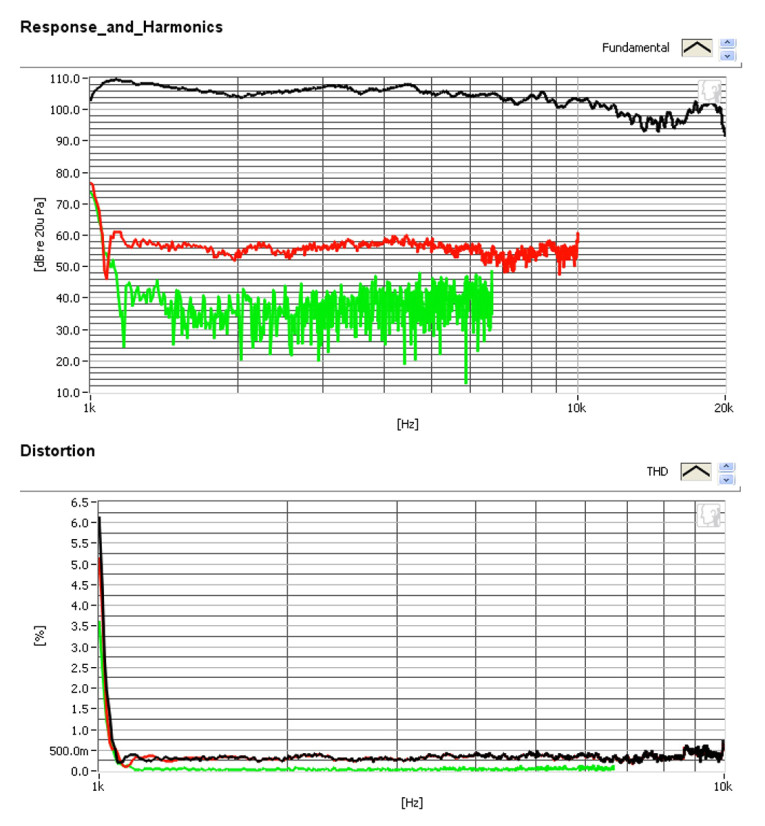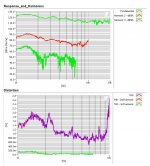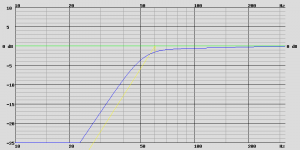I am not so sure about HOMs being a major issue with the XT1086. 18Sound (now owned by B&C) use very sophisticated tools (both hard- and software) in their labs.
Their horns are have all been developed based on extensive simulation and optimization in Comsol, similar to what Harman has done in developing their PT and Image Control waveguides. Kef and Celestion (also) use Siemens PLM to develop their waveguides, annular diaphragms and phase plugs, which is more or less comparable.
Take a look at this:
An externally hosted image should be here but it was not working when we last tested it.
More than a few sudden discontinuities, but I haven't read any comments about the M2 suffering from HOMs so far.
Even with older drivers that were not (at all) developed for specific use with the M2 waveguide, people praise the "smoothness" it adds to the sound.
On the Audioheritage forum there are plenty of threads on the M2 waveguide.
IMHO the aggressive breaks of the M2 are mostly for cosmetic reasons. The successive models are much more similar to the JBL progressive transition waveguide.
The M2 waveguide is a diffraction horn, and so is the XT1086. The clever thing about the M2 is that there are actually TWO diffraction slots layered on top of each other. One is at a 45 degree angle, and the other is angled at -45.
$34.000

For near field listening, I would recommend a smaller horn with an 6-8" woofer (+ subs). This are 2 favorites and both around 80° in the horizontal.
Too many forums where these have been measured and used in projects, but you might start with googling "Econowave 18Sound".
I'm using two 12 because they are peaking at more than 100dB at the crossover point and stay above 95dB at 100Hz, a 6' would sound anemic in comparison.
PS : the Gedlee designs are not able to maintain a good efficiency at 100Hz, i still don't understand

I'm not sure what is meant by 'angled' here. The coverage angle?
EDIT: I just realised the answer - that multiple horns were being discussed in one post, not just the XT-1464 (18 sound) clone.
As for HOMs, when he was asked about a similar horn (XT1086), Dr Geddes said:
Something like this looks like a pretty good alternative, short and looks like a simple shape (no sharp angles / low HOM?). I like the flat front, which means one could possibly rear mount it + chamfer the baffle to get a smoother mouth edge, (and have less black plastic on view).
Seven dollars.
Not enough loading with this one, is the diffraction an issue in small reverberant rooms ?
IMHO the aggressive breaks of the M2 are mostly for cosmetic reasons
Aggressive breaks are not problematic when they are made by Harman ?
I'm not sure what is meant by 'angled' here. The coverage angle?
EDIT: I just realised the answer - that multiple horns were being discussed in one post, not just the XT-1464 (18 sound) clone.
As for HOMs, when he was asked about a similar horn (XT1086), Dr Geddes said:
Something like this looks like a pretty good alternative, short and looks like a simple shape (no sharp angles / low HOM?). I like the flat front, which means one could possibly rear mount it + chamfer the baffle to get a smoother mouth edge, (and have less black plastic on view).
Seven dollars.
This small elliptical horn should work with an 8" woofer, crossed around 2KHz. The flat front may cause some edge diffraction, but probably not enough to worry about. The XT120 will most likely outperfom it though.
It's the same with the XT-1464 vs. the similar sized Faital-Pro LTH-142. They are comparable, but the XT-1464 both measures and sounds better.
I'm using two 12 because they are peaking at more than 100dB at the crossover point and stay above 95dB at 100Hz, a 6' would sound anemic in comparison.
PS : the Gedlee designs are not able to maintain a good efficiency at 100Hz, i still don't understand
An externally hosted image should be here but it was not working when we last tested it.
The 15TBX100 used in the Summa is about 95dB, if you add some losses due to BSC you'll end up in the low 90's sensitivity.
It's an otherwise well behaved driver, but personally I wouldn't choose a 15" with an Mms of 163 g for a big 2 way, especially if it's tuned for midbass and intended to be used with seperate subs. To me it makes more sense to choose a lighter cone with a stiffer suspension, but sufficient motor force.
Qts just below 0.40 / BL > 17 / Mms < 80 g / Fs of ca. 40 Hz.
You'll need a big cab, but end up with higher sensitivity and most importantly: a very snappy midrange (where most of the music is). As an added bonus: crossover will most likely be easier to get right, because such a woofer is usually less strained at higher freqs, both acoustically (soundwise) and mechanically.
If you put such a driver in a large cab (WAF should be a non-issue) you could tune it close to .0707 and enjoy a very clean mid bass and some sub bass without "overhang" (aka "slow", bottom heavy bass due to a lack of mid bass and too much sub bass) and.... without using subs.
Last edited:
It's the same with the XT-1464 vs. the similar sized Faital-Pro LTH-142.They are comparable, but the XT-1464 both measures and sounds better.
If I read the datasheets properly then the Faital is smaller. I always wondered what the differences are sound-wise but I have never got an answer. I use the XT1464 with a Faital HF 146 and I am quite content with it. But the Faital one would look nicer and less bulky.
regards
Charles
IMHO the aggressive breaks of the M2 are mostly for cosmetic reasons. The successive models are much more similar to the JBL progressive transition waveguide.
The M2 waveguide is a diffraction horn, and so is the XT1086. The clever thing about the M2 is that there are actually TWO diffraction slots layered on top of each other. One is at a 45 degree angle, and the other is angled at -45.
That's what I gathered from the "M2 for the poors" thread. The idea being: by creating enough diffraction it (eventually) becomes a none issue. I am not so sure about this. It makes more sense the M2 waveguide is the result of well behaved pressure distribution, a product of modeling and optimization.
The 15TBX100 used in the Summa is about 95dB, if you add some losses due to BSC you'll end up in the low 90's sensitivity.
It's an otherwise well behaved driver, but personally I wouldn't choose a 15" with an Mms of 163 g for a big 2 way, especially if it's tuned for midbass and intended to be used with seperate subs. To me it makes more sense to choose a lighter cone with a stiffer suspension, but sufficient motor force.
Qts just below 0.40 / BL > 17 / Mms < 80 g / Fs of ca. 40 Hz.
You'll need a big cab, but end up with higher sensitivity and most importantly: a very snappy midrange (where most of the music is). As an added bonus: crossover will most likely be easier to get right, because such a woofer is usually less strained at higher freqs, both acoustically (soundwise) and mechanically.
If you put such a driver in a large cab (WAF should be a non-issue) you could tune it close to .0707 and enjoy a very clean mid bass and some sub bass without "overhang" (aka "slow", bottom heavy bass due to a lack of mid bass and too much sub bass) and.... without using subs.
I still believe that Gedlee has a good technical reason, i don't find it
I've opted for the solution that you've descibed (25L cabs) and intergrated the LF abilities of the front speakers in the multisub setup.
It is better, but i still tinking that i've missed something in my understanding
If I read the datasheets properly then the Faital is smaller. I always wondered what the differences are sound-wise but I have never got an answer. I use the XT1464 with a Faital HF 146 and I am quite content with it. But the Faital one would look nicer and less bulky.
regards
Charles
I was about to buy a pair of LTH-142's, but after reading some comments of people who compared it to the XT-1464, I decided to cancel. The LTH-142 tends to beam quite a lot due to the tractrix contour and it's subsequent depth/width/height ratio. The XT-1464 is larger and features an optimized mouth (with roundover). It will still beam, but less annoyingly so, aspecially with near- and midfield listening.
It's quite easy to understand if you compare both horns: which one looks more akin to a trumpet?
I still believe that Gedlee has a good technical reason, i don't find it
I've opted for the solution that you've descibed (25L cabs) and intergrated the LF abilities of the front speakers in the multisub setup.
It is better, but i still tinking that i've missed something in my understanding
Dr. Geddes undoubtedly selected his drivers based on fundamental technical objectives. As always: it's a matter of trade-off, pick your poison etc.
I am not a fan of using separate subs for hi-fi (music) use and have hardly any experience in setting up such a system myself. I have listended to many though and, with a few exceptions, don't like it for music. For home cinema: it's a different story.
By the way: Why not include (part of) the sub duties in the main cabs? 30Hz and below.... apart from a few church organ works, there's not much music with sub bass content.
Last edited:
Follow up:
Come to think about it: not so long ago I set up subs for an omnidirectional loudspeaker system. These were special OEM Kef coaxials with inversed cones in a small tube shaped case. The subs were 15", 2 separate cabs. Although these might not be called subs in the true sense, because they covered 25-80 (max 120) Hz. This setup, once properly dsp-ed (with Dante) did perform quite well. The omni tubes are quite forgiving in this respect, integration that is.
... Back to Biradials, I guess
Come to think about it: not so long ago I set up subs for an omnidirectional loudspeaker system. These were special OEM Kef coaxials with inversed cones in a small tube shaped case. The subs were 15", 2 separate cabs. Although these might not be called subs in the true sense, because they covered 25-80 (max 120) Hz. This setup, once properly dsp-ed (with Dante) did perform quite well. The omni tubes are quite forgiving in this respect, integration that is.
... Back to Biradials, I guess
I'm sure they know what they are doing
Regarding HOM, Dr Geddes argues for reducing it (and diffraction) to an absolute minimum.
It looks like the 18 sound people compromise that a little to get the loading and coverage angle they need for pro use. The optimisation and amount of compromise is no doubt good, so maybe the difference between them and a Geddes clone of equivalent dimensions would be inaudible / only academic.
I haven't used an 18 Sound horn or a HOM optimised oblate spheroid, but I imagine I'd like both. The 1464 looks good here (maybe too good, is that distortion test a real thing)?
Test Bench: Eighteen Sound ND3ST 1.4” Compression Driver
Agreed on HOMs and compromises to be made.
Remember: even OS waveguides generate a moderate amount of HOMs.
You mean these plots? :

Very good, but not unusual I would think.
Did you notice distortion skyrocketing towards 1K?
Last edited:
You mean these plots? :
[..]
Very good, but not unusual I would think.
Did you notice distortion skyrocketing towards 1K?
They seem unusually low compared to another 1.4" (B&C) that is presumably measured the same way. The 18 Sound is around 0.25% THD above 1kHz whereas the B&C is 1-2%
I'm just academically curious, I'm not shopping for either.
Attachments
PS : the Gedlee designs are not able to maintain a good efficiency at 100Hz, i still don't understand
I don't understand this comment either. A NS-15 has incredible efficiency at 100 Hz - something like 96 dB. I let them roll off naturally below about 70 Hz because that blends better with multiple subs. They could be ported and go down to 40 Hz or so, but I would never suggest that as it is just not the right thing to do.
Last edited:
I still believe that Gedlee has a good technical reason, i don't find it
(
Then you are not looking. I use a 15NBX100 in the NS-15 because its sensitivity is high, its power handling is high, and it has a nice well controlled high end. Lighter cones don't do that as well.
Then you are not looking. I use a 15NBX100 in the NS-15 because its sensitivity is high, its power handling is high, and it has a nice well controlled high end. Lighter cones don't do that as well.
This design argument is valid with passive crossovers, in an active configuration with a very steep crossover slope the cone breakups seems not as problematic, will you recommend the same unit with an active filter ?
Ok, I did a quick and dirty sim and got: VB = 72.1 L, FB = 48.0 Hz, 0 dB corresponds to 96.1 dB/2.83V/m.
No doubts here anymore about 96dB
Even with 25 liters a 15' would be also my first choice, but they are too high for proximity monitors, the horn should be at the ear level when the listener is seated.
With a 800mm height table a baffle of 320mm is the absolute maximum for my body.
Despite the technical flaws of my cheap radial horns, i really feel that they are underrated, they provide a very good dispertion pattern (in term of surface) for a highly reverberant small room and the vast sweet spot is very comfortable.
Last edited:
I don't understand this comment either. A NS-15 has incredible efficiency at 100 Hz - something like 96 dB. I let them roll off naturally below about 70 Hz because that blends better with multiple subs. They could be ported and go down to 40 Hz or so, but I would never suggest that as it is just not the right thing to do.
Agreed. I was 95% happy with my Summas. My only gripe was that the cabinet is so darn big!
I've been working lots of overtime in the last 18 months, and I'm hoping to buy a home that's big enough to accommodate a speaker that size.
(When I sold my Summas I was living in a 2br condo with my wife and two kids. There simply wasn't any room for the speakers.)
Long story short: they're great speakers but probably too large if you live in a teeny tiny condo in San Diego.
Big cabs need air to breath. I temporarily parked my 250 Liter cabs at my brother's place for the same reason. You bought some KEFs LS (50?), if I remember correctly? And you like to listen listen to EDM? Don't you regret selling the Summa's then?
Wouldn't a 10 or 12" be a more viable option in your case? (Unless these radials are similar to the JBL 2345 or it's bigger brothers)
Even with 25 liters a 15' would be also my first choice, but they are too high for proximity monitors, the horn should be at the ear level when the listener is seated.
With a 800mm height table a baffle of 320mm is the absolute maximum for my body.
Despite the technical flaws of my cheap radial horns, i really feel that they are underrated, they provide a very good dispertion pattern (in term of surface) for a highly reverberant small room and the vast sweet spot is very comfortable.
Wouldn't a 10 or 12" be a more viable option in your case? (Unless these radials are similar to the JBL 2345 or it's bigger brothers)
Last edited:
- Home
- Loudspeakers
- Multi-Way
- How to Make a New Wave Biradial Horn


